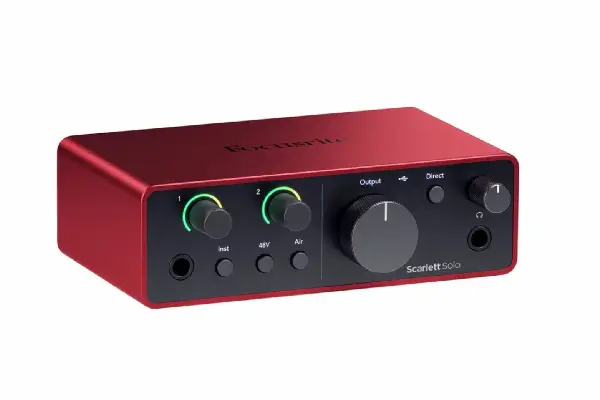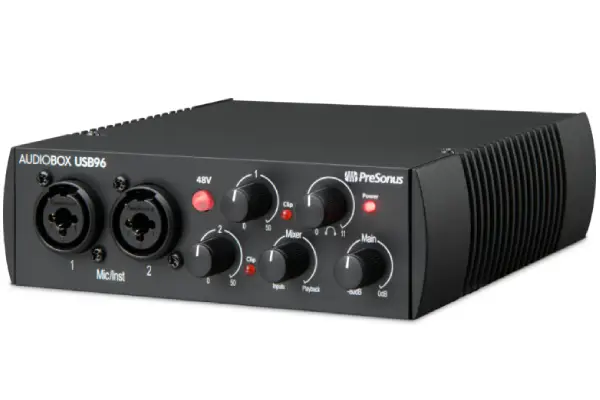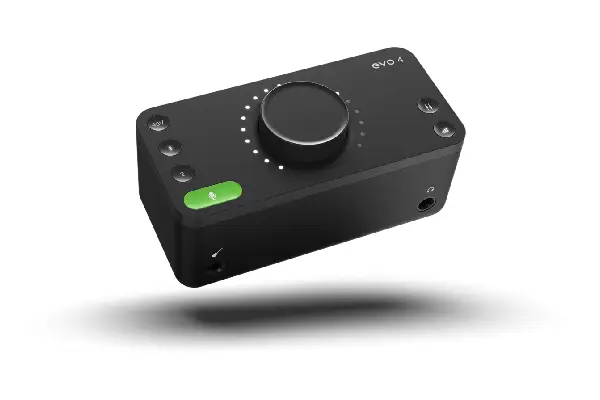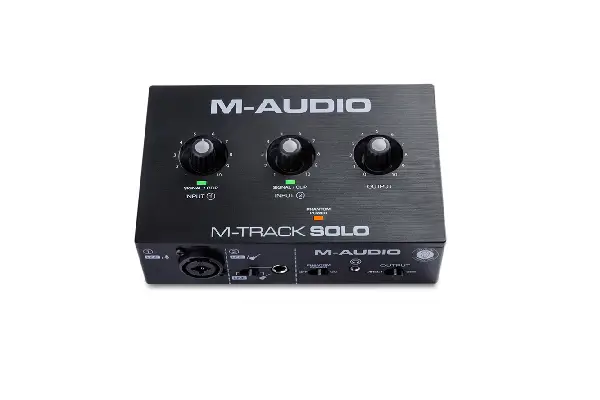Finding the best audio interfaces under $100 might seem like searching for a needle in a haystack, but the budget recording interface market has exploded with genuinely capable options over the past few years Whether you’re a bedroom producer laying down vocal tracks, a guitarist wanting to capture clean DI signals, or a podcaster needing reliable XLR inputs, there’s actually legitimate gear in this price range that won’t hold back your creativity. The trick with budget interfaces isn’t just finding the cheapest option—it’s identifying which compromises you can live with and which features matter most for your workflow.
| Model | Key Strengths | Pros | Cons |
|---|---|---|---|
| Focusrite Scarlett Solo (3rd Gen) | Clean, reliable single-input interface with Air mode and great build for beginners | • Sturdy metal chassis• Transparent preamps + Air mode• Stable drivers (Mac/Windows)• Good software bundle• Low-latency direct monitoring | • Only one combo input• No MIDI ports• Direct monitor lacks blend control• Gain knob easy to bump |
| Behringer U-Phoria UMC22 | Ultra-budget interface with decent preamps and surprising durability | • Extremely affordable• Robust enough for travel• Stable drivers• Compact size• Phantom power works reliably | • Preamps slightly colored• No direct monitor blend• Limited headroom with hot pickups• Basic metering• No software bundle |
| PreSonus AudioBox USB 96 | Two-input budget interface with excellent monitoring flexibility and solid build | • Two combo inputs for dual recording• Mix knob for monitor blending• XMAX preamps with musical character• Strong metal chassis• Great integration with Studio One | • Bigger than minimal interfaces• Drivers require more setup on non-Studio One DAWs• Weak headphone amp• No MIDI ports• Gain knobs loosen over time |
| Audient EVO 4 | Modern, innovative interface with Smartgain and high-quality Audient preamps | • Smartgain automatic gain setup• Excellent Audient preamp sound• Built-in loopback for streaming• Great software bundle• Compact, intelligent UI | • Motion UI has learning curve• Only one dedicated instrument input• No traditional knobs• USB-C requires adapters on older hardware• Only two outputs |
| M-Audio M-Track Solo | Optimized for guitar/bass DI recording with strong instrument input and portability | • Great DI sound for instruments• Strong headphone amp• USB-C bus-powered portability• Ideal impedance for passive pickups• Tactile detented gain knob | • Basic software bundle• No direct monitor blend• Only one combo input• Plastic housing• No MIDI support |
Focusrite Scarlett Solo (3rd Gen)

The Focusrite Scarlett Solo has become something of a rite of passage for home recording enthusiasts, and after using mine extensively for everything from tracking demo vocals to recording bass guitar direct, I understand why this interface has achieved near-legendary status in the budget category. The third generation brought meaningful improvements over the previous version, particularly in the preamp department where Focusrite implemented their Air mode—a subtle high-frequency enhancement that genuinely adds presence and clarity to vocal recordings without sounding artificial or harsh.
The direct monitoring feature works flawlessly for tracking with zero latency, though I’ll admit the single headphone output means you’ll need an external splitter if you’re trying to give separate headphone mixes to multiple musicians (a limitation worth noting for anyone tracking bands). The included Ableton Live Lite software and plugin bundle adds genuine value, especially for beginners who don’t already own a DAW. One quirk I discovered: the instrument input impedance works beautifully with passive guitar pickups, but my active bass sometimes felt a touch sterile compared to going through my dedicated bass preamp first—though this is honestly nitpicking given the $100 price point. If you’re interested in exploring more instruments and how different gear affects their recorded sound, that relationship between source and interface becomes endlessly fascinating.
Pros:
- Exceptional build quality with sturdy metal chassis
- Clean, transparent preamps with useful Air mode enhancement
- Reliable drivers across Mac and Windows platforms
- Comprehensive software bundle included
- Low latency performance suitable for real-time tracking
Cons:
- Single combo input limits simultaneous recording options
- No MIDI connectivity for keyboard integration
- Direct monitor mix is simple without blend control
- Gain knob placement vulnerable to accidental adjustment
Behringer U-Phoria UMC22

The Behringer UMC22 represents the absolute entry point for legitimate recording interfaces, and while I initially approached it with skepticism (Behringer’s reputation for ultra-budget gear can be polarizing), this little interface surprised me with its straightforward competence. I picked one up specifically for a portable recording setup I wanted for capturing song ideas on the road, and it’s lived in my backpack for the better part of a year, surviving treatment that would’ve destroyed more delicate gear.
Let’s be clear upfront: this isn’t going to compete with interfaces costing three times as much in terms of preamp quality or feature sophistication, but it absolutely gets the job done for basic recording tasks. I’ve tracked dozens of acoustic guitar sessions through the UMC22, and while the preamps have a slightly colored character (there’s a subtle midrange emphasis that can actually flatter vocals), they’re quiet enough for bedroom recording levels. The 48V phantom power works reliably with my budget condenser mics, though I did notice it takes a few seconds longer to stabilize compared to higher-end interfaces.
The direct monitoring switch is either on or off with no blend control, which means you’re choosing between hearing only your input signal or only your DAW playback—not ideal, but manageable once you adapt your workflow. What genuinely impressed me was the driver stability. The instrument input handles guitar signals competently, though high-output humbuckers occasionally push it toward slight distortion at higher gain settings (easily remedied by turning down your guitar volume or using the pad switch if tracking particularly hot sources). For anyone starting their recording journey or needing a truly backup interface that won’t break if it falls off your desk, the UMC22 delivers remarkable value—it’s the interface equivalent of a reliable Honda Civic, unglamorous but dependable.
Pros:
- Unbeatable price point for legitimate recording capability
- Surprisingly robust build despite plastic housing
- Stable drivers across multiple operating systems
- Compact footprint ideal for mobile recording setups
- Functional phantom power for condenser microphones
Cons:
- Preamps lack the transparency of higher-tier options
- No blend control for direct monitoring
- Limited headroom before distortion with hot sources
- Basic gain staging without detailed metering
- No included software bundle
PreSonus AudioBox USB 96

The PreSonus AudioBox USB 96 occupies an interesting middle ground in the budget interface market—more capable than bare-bones options but still comfortably under $100—and after several months tracking everything from podcast dialogue to electric guitar amps, I’ve come to appreciate its thoughtful design choices. PreSonus clearly built this interface for musicians who need flexibility beyond single-input recording, providing two combo XLR/instrument inputs that enable simultaneous tracking of vocals and guitar or stereo microphone configurations.
What sets the AudioBox apart from similarly-priced competitors is the attention to workflow details that suggest PreSonus actually talked to working musicians during development. The Mix control knob lets you blend between direct monitoring and DAW playback seamlessly—a feature I use constantly when tracking vocals since I can dial in exactly how much reverb or compression I want to hear from my DAW while maintaining the immediacy of direct input monitoring. The XMAX preamps deliver clean gain with character that sits nicely between the clinical transparency of the Scarlett and the colored warmth of more vintage-styled preamps; I’ve found they flatter dynamic microphones particularly well, making them excellent for recording guitar cabinets or snare drums.
Build quality feels substantial without being heavy—the metal chassis resists the flexing that plagues cheaper plastic interfaces, and the rubberized bottom keeps it planted during energetic recording sessions where you’re reaching for gain knobs mid-take. I did encounter one persistent quirk: the included Studio One Artist DAW software integrates beautifully with the hardware (literally plug-and-play), but if you’re committed to using Ableton or Logic, you’ll need to do more driver configuration than with some competitors. The phantom power works flawlessly across both channels simultaneously, something not every budget interface handles cleanly. For anyone recording multiple sources regularly or working with songs that require layering multiple instrument tracks, those two inputs become genuinely liberating compared to single-input alternatives.
Pros:
- Dual combo inputs enable simultaneous two-channel recording
- Mixer-style blend control for monitoring flexibility
- XMAX preamps deliver musical character with low noise
- Solid metal construction with protective rubber base
- Excellent integration with Studio One Artist DAW
Cons:
- Slightly larger footprint than ultra-compact competitors
- Driver setup more involved with non-Studio One DAWs
- Headphone amplifier lacks power for high-impedance headphones
- No MIDI connectivity for keyboard workflow integration
- Gain knobs feel slightly loose after extended use
Audient EVO 4

The Audient EVO 4 represents a genuinely fresh approach to budget interface design, and from the moment I started using it, the thoughtful innovations became apparent—this isn’t just another me-too interface copying existing designs but rather Audient applying their considerable audio engineering expertise to reimagining what entry-level gear could accomplish. The standout feature is Smartgain, an automatic level-setting system that analyzes your input source and sets optimal gain levels with a single button press, eliminating the frustrating guesswork that plagues beginners trying to achieve proper recording levels without clipping.
The loop-back functionality deserves special mention; it routes your computer’s audio back through the interface, making it perfect for streaming, podcasting, or recording software instruments alongside external sources without complicated software routing. Audient’s preamp heritage shines through here—the company builds recording consoles for professional studios, and you can hear that DNA in the EVO 4’s surprisingly refined sound quality. Vocals recorded through this interface maintain detail and presence that rivals interfaces costing significantly more, with extended high-frequency response that captures breath and nuance without harshness.
The Motion UI control system (using the central button and surrounding LEDs to access different functions) took some getting used to compared to traditional knobs and switches, but I’ve grown to appreciate its efficiency once the workflow clicked. The included software bundle is particularly generous, providing Cubase LE and a substantial plugin collection that genuinely expands your production capabilities. One consideration: the two inputs can’t both be used as instrument-level simultaneously—you’ll need a DI box if you want to record two guitars at once (though one instrument input plus one mic input works perfectly). When comparing monitoring solutions, checking out compare-headphones options helps ensure you’re hearing what this capable interface actually delivers.
Pros:
- Smartgain automatic level-setting works remarkably well
- Professional-quality Audient preamps at budget pricing
- Loop-back functionality perfect for streaming and podcasting
- Generous software bundle with useful plugins included
- Compact design with intelligent Motion UI controls
Cons:
- Motion UI requires learning curve for traditional users
- Only one dedicated instrument-level input available
- No traditional physical gain knobs for quick adjustments
- USB-C connection requires adapter for older computers
- Limited to two outputs without expanded monitoring options
M-Audio M-Track Solo

The M-Audio M-Track Solo often gets overlooked in discussions dominated by Focusrite and PreSonus, which is somewhat unfortunate because this interface brings specific strengths that make it the right choice for particular use cases—particularly for guitarists and bass players who prioritize instrument recording over microphone work. After spending several weeks using it as my primary tracking interface for guitar overdubs, I’ve developed appreciation for M-Audio’s design priorities here, which clearly focused on delivering exceptional direct instrument recording capability at an accessible price point.
The included software package leans heavily toward M-Audio’s own plugins and sounds, which is fine for beginners but feels less comprehensive than what Focusrite or PreSonus bundle with their interfaces. The direct monitoring works well, though it’s a simple on/off switch without blend control—you’re either hearing pure input signal or pure DAW output. For anyone building a guitar-centric recording setup or needing an interface that excels specifically at capturing clean, uncolored instrument tones, the M-Track Solo deserves serious consideration despite its lower profile in the market. The relationship between your instrument tone and recording chain matters tremendously, which is why exploring instruments and their unique characteristics helps you make informed gear decisions.
Pros:
- Crystal preamps excel with direct instrument recording
- Powerful headphone amplifier drives high-impedance headphones
- USB-C bus-powered operation for genuine portability
- Optimized instrument input impedance for passive pickups
- Detented gain control provides tactile feedback
Cons:
- Software bundle less comprehensive than competitors
- No blend control for direct monitoring
- Single combo input limits recording flexibility
- Plastic housing feels less substantial than metal alternatives
- No MIDI connectivity for integrated keyboard workflow
Frequently Asked Questions
Do I really need an audio interface if I’m just starting out recording music?
Yes, if you want professional-quality recordings, an audio interface is essential. Your computer’s built-in audio hardware simply can’t match the preamp quality, conversion accuracy, or low-latency performance that even budget interfaces provide. I’ve worked with countless beginners who struggled with frustrating latency issues and noisy recordings using their laptop’s mic input, only to experience immediate improvement after investing in an entry-level interface. The difference in recording quality justifies the investment from day one, particularly if you’re serious about developing your production skills.
Can these budget interfaces handle professional condenser microphones?
Absolutely—all five interfaces reviewed here provide proper 48V phantom power and sufficiently clean preamps for condenser microphones. I’ve used each with my Audio-Technica AT2020 (a popular studio condenser) and achieved recordings that held up in final mixes alongside tracks recorded through significantly more expensive gear. The preamp quality won’t match $500+ interfaces, but the limitations become apparent only when you’re recording extremely dynamic sources or pushing for the absolute last bit of detail in critical listening environments. For home recording, podcasting, and even professional demo production, these interfaces deliver perfectly usable condenser mic performance.
How important is having two inputs versus just one?
This depends entirely on your recording workflow. If you primarily track one element at a time—vocals over pre-recorded backing tracks, guitar overdubs, or solo podcast recording—a single input interface like the Scarlett Solo or M-Track Solo works perfectly and saves money. However, dual inputs become invaluable when recording acoustic guitar and vocals simultaneously, conducting two-person podcasts, or capturing stereo sources like piano or drum overheads. I find myself reaching for my dual-input interfaces far more often than expected, simply because the flexibility opens creative possibilities I wouldn’t attempt with single-input limitations. If you’re exploring different compare-earbuds for monitoring while tracking, having that flexibility in your interface matters just as much.
Will these interfaces work with my iPad or iPhone for mobile recording?
Most modern USB interfaces work with iOS devices through Apple’s Camera Connection Kit or USB-C adapters, though power requirements vary. The M-Audio M-Track Solo and Audient EVO 4 (both USB-C) connect particularly smoothly to newer iPads. However, you’ll need to verify that your specific interface model officially supports iOS and consider whether you’ll need an externally powered USB hub to provide sufficient power, since iPads can’t always provide enough juice for interfaces with phantom power enabled. I’ve successfully used the Scarlett Solo with my iPad for mobile recording sessions, though I needed to keep phantom power off to avoid power drain issues.
How much difference does preamp quality actually make in these budget interfaces?
Preamp quality affects noise floor, headroom, and tonal character—differences that become increasingly apparent as your critical listening skills develop. When I first started recording, honestly, I couldn’t hear much difference between budget and boutique preamps, but after years of mixing, those distinctions became obvious. In the budget interface category, the variation isn’t dramatic; the Audient EVO 4 and Focusrite Scarlett series have slightly cleaner, more transparent preamps than the Behringer UMC22, but all are quiet enough for home recording where room noise typically dominates anyway. The preamp differences matter more when recording quiet sources like acoustic instruments or subtle vocals where you’re pushing the gain significantly. For rock vocals, electric guitars, and most podcasting applications, any of these interfaces will serve you well.

